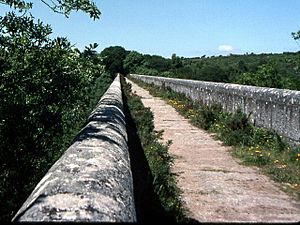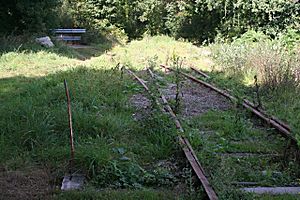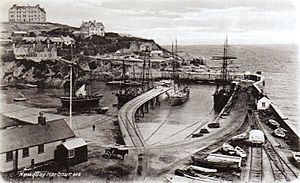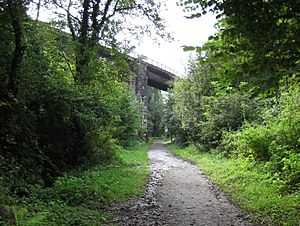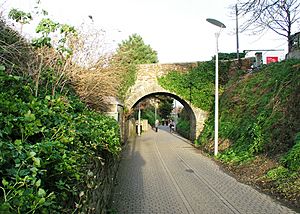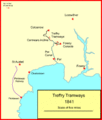Treffry Tramways facts for kids
The Treffry Tramways were a network of special railways in Cornwall, England. They were built by a local landowner named Joseph Treffry (1782–1850). These tramways helped transport heavy materials like metals, granite, and china clay from mines and quarries. The lines stretched between the Luxulyan Valley and Newquay.
Horses pulled the wagons on these lines. Water power and steam engines were used on steep slopes called inclines. At first, the tramways worked with the Par Canal and Par Docks, which Treffry also built. One part of the tramway crossed the Luxulyan Valley on a huge bridge called the Treffry Viaduct. It was the biggest bridge in Cornwall when it was built.
The tramways opened in different stages from 1835 to 1870. They made it much easier to move minerals. However, the technology was a bit old-fashioned. In 1874, a wealthy company called the Cornwall Minerals Railway took them over. This company spent a lot of money to improve the lines. They made them suitable for steam trains and extended them.
The first parts of the tramways were built as a private project, so no special law was needed. People sometimes called them "Treffry's Railway." A "tramway" is a simple railway that isn't usually fenced off.
Today, some parts of the old tramway routes are still used by passenger trains. These trains run as the Atlantic Coast Line between Par and Newquay.
Contents
- History of the Treffry Tramways
- Building the Par Canal and Mine Connections
- Connecting Par Consols Mine
- From Pontsmill to Colcerrow Quarry
- Building the Treffry Viaduct to Molinnis
- Reaching Newquay Harbour
- Later Extensions and Challenges
- Problems with Steam Trains
- Changing Times and New Ownership
- The Cornwall Minerals Railway Takes Over
- See also
- Images for kids
History of the Treffry Tramways
Building the Par Canal and Mine Connections
Joseph Treffry owned large areas of land in Cornwall. He had mines in the high ground around the Luxulyan Valley. Moving the heavy minerals from these mines to places where they could be sold was very hard. They had to use horse-drawn carts on bad roads.
Treffry lived in Fowey, which had a deep harbor for ships. He had improved the docks there in 1811 and 1813. He wanted to build a tramway to bring minerals from the Luxulyan Valley to Fowey. But another landowner, Charles Rashleigh, owned land in the way. Rashleigh also owned a harbor at Charlestown, which would lose business if Treffry built his tramway. So, Rashleigh would not let Treffry use his land.
Treffry then decided to build a harbor at Par. He finished it in 1833. He also built the Par Canal, which connected Pontsmill to the new harbor. The canal was ready in 1840. Treffry had a mine called Lanescot, which later became the very rich Fowey Consols mine. He built a small tramway on a steep slope (an inclined plane) to move minerals from the mine to Pontsmill.
This first tramway was 1,127 feet (344 meters) long. It worked by itself, using gravity, and had a short tunnel. A second, longer inclined tramway was also built. It was 2,640 feet (805 meters) long and included an 840-foot (256-meter) tunnel. This one had two tracks and was powered by a 30-horsepower (22 kW) water wheel. The water for the wheel came from a 4-mile (6.4 km) long channel called a leat.
The incline started working in 1835. Pontsmill became a busy place for processing minerals. China clay was brought to the canal basin from the Hensbarrow area. Treffry also installed a very powerful 80-inch (2-meter) steam engine at Fowey Consols. This engine, called the Austen engine, showed how much Treffry used new industrial ideas.
Moving copper was a big job. Coal had to be brought in for the engines, and the copper ore had to be shipped out to refining plants. Both trips involved sailing around Land's End, which was a difficult and dangerous journey. In 1835, Treffry announced his plan to connect Par and Newquay with a tramway or railway. Newquay had a small harbor on the north coast, which was better for shipping to South Wales.
Connecting Par Consols Mine
Treffry used the same idea of inclined tramways to connect the Par Consols mine. This mine was on high ground northwest of Par Harbour. The tramway was 870 feet (265 meters) long with a steep slope. Most of the traffic went downhill, but coal had to be brought up to the mine. Since there was no water for a water wheel, Treffry had to use a steam engine to pull things up. This tramway started in 1841.
From Pontsmill to Colcerrow Quarry
Even with the tough hills, Treffry planned the first part of the route to Newquay. This section went from Pontsmill to Colcerrow Quarry, just under 2 miles (3.2 km) away. The first part was another steep slope called the Carmears Incline, about 950 yards (869 meters) long. After that, the line was mostly flat. This section opened in 1841. The incline used cables pulled by a large water wheel. This wheel was 30 feet (9.1 meters) wide and 8 feet 6 inches (2.59 meters) deep. It produced 76 horsepower and could lift 30 tons up the incline in 10 minutes. Many new water channels (leats) were built to bring water to the wheel. Later, a leat was even carried over the Treffry Viaduct. The track used T-shaped rails on stone blocks and was a single line of standard width.
This line was built on Treffry's own land or with agreements from other landowners. So, he didn't need a special law from Parliament. Even though steam trains were already proving useful, Treffry chose horses because they were cheaper to operate. He also preferred water wheels over steam engines when water was available, because coal was expensive in Cornwall. Minerals brought to Pontsmill were moved onto barges on Treffry's canal. From there, they went to Par Harbour and then onto ships.
Building the Treffry Viaduct to Molinnis
The short line to Colcerrow was just the beginning. The tramway was extended to Molinnis, near Bugle. The ground here was easier, but the line needed to cross to the west side of the valley. So, a huge bridge, the Treffry Viaduct, was built. It was 648 feet (198 meters) long with ten arches and stood 98 feet (30 meters) high. It was the first large granite bridge in Cornwall. Its first stone, weighing 10 tons, was laid in March 1839. Besides carrying the tramway, it also held a water channel (leat) that brought water down to the Carmears waterwheel.
The viaduct cost £6,708 to build. James Meadows Rendel was the engineer, and William Pease managed the project. To build the viaduct, a temporary inclined tramway was made, about 100 meters (328 feet) long.
The Molinnis end of the line, near the Bugle Inn, gave access to many mines in that area. These mines produced china clay, china stone, and tin. This part of Treffry's tramway opened in early 1844.
In 1855, the line from Pontsmill to Bugle was extended all the way to Par Harbour, running next to the Par Canal. This meant goods no longer had to be transferred from the tramway to the canal at Pontsmill.
Reaching Newquay Harbour
While Treffry focused on the southern part of his line, work started by 1844 on a line from Newquay Harbour. This line went to East Wheal Rose, an important lead mine southeast of St Newlyn East, which is about 4 miles (6.4 km) south of Newquay. Work also began on connecting to St Dennis and Hendra, about 10 miles (16 km) east of Newquay. These places were planned to be on the main line to Molinnis.
An Act of Parliament, the Newquay (Cornwall) Pier and Harbour Act 1844, was passed in 1844 for the "Treffry Estate Railway, or Newquay Railway." This might have been because the Newquay line involved more public work. Another Act in 1857, the Treffry's Estate (Newquay Railway) Act 1857, confirmed the right to run the lines. It also allowed some planned but unbuilt sections to be abandoned. This later Act said that steam trains could not be used without approval from the Board of Trade.
The line from Newquay Harbour to East Wheal Rose was working by February 1849. The line to St Dennis and Hendra Crazey opened in June 1849. There were china clay mines on Hendra Downs, high above St Dennis. For a while, the planned connection there was not made.
The line had three tunnels. One was on the incline to Newquay Harbour. Another was at Coswarth, which was only 44 yards (40 meters) long, more like a bridge. The third was Toldish Tunnel, 500 yards (457 meters) long. The incline from Newquay Harbour was very steep and used a stationary engine with a wire rope.
The main line crossed the Trenance Valley on a bridge 98 feet (30 meters) high and 210 yards (192 meters) long. This bridge was made of wooden supports on seventeen stone pillars. It looked so fragile that people called it the Tolcarne Spider.
Later Extensions and Challenges
Treffry wanted to connect the two parts of his tramway to create a system from coast to coast. But he became ill, and the market for minerals was bad, which delayed his plans. He passed away on January 29, 1850. His estate then faced many legal problems. His cousin, Edward Willcocks, managed the estate and later changed his name to Edward Willcocks Treffry.
Under his management, the Hendra Downs incline was prepared by 1852, though it might not have started working until 1857. It connected the china clay mines on high ground to the St Dennis section at Gullies Wharf. It was powered by a beam engine.
Around 1855, a branch line was built from the Colcerrow branch to serve smaller quarries at Cairns, northeast of Luxulyan.
The Pontsmill section of the tramway was extended down to Par Harbour in 1855. This meant goods could go directly to ships at Par Harbour without being transferred to the canal at Pontsmill. The Cornwall Railway was being built at this time, but it didn't open until 1859. That railway used a wider track (broad gauge), so it couldn't connect directly with Treffry's tramways at first.
Problems with Steam Trains
When Treffry first built his tramways, he chose horses because they were cheaper to run. He also used water wheels whenever possible because coal was expensive. By 1860, the problems with Treffry's lines became clear. They were not efficient enough. An investigation looked into using steam trains. But the Carmears incline was too steep for trains. A report by Captain H. W. Tyler of the Railway Inspectorate was not positive. He said the rails were too light, the supports were too far apart, and the bridges and tunnels were too low and narrow for steam engines.
Changing Times and New Ownership
The Fowey Consols Mine did not last forever. By 1865, it was empty of minerals and closed, along with its tramways. Copper mining in the Luxulyan Valley area declined around that time. While some tried to mine tin, it wasn't very successful. However, granite quarrying became more popular. New, smaller quarries opened at Rock Mill Quarry and Orchard Quarry, above Pontsmill. In 1870, a branch of the tramway was extended from near Pontsmill to serve these two quarries. This line had two branches that crossed the river. The Orchard Quarry line had an incline, likely narrow gauge and gravity-operated.
Joseph Treffry's choice in 1844 to use horses made his tramways outdated. By the 1870s, they were very inefficient. It was clear they needed to be updated, but the Treffry Estate didn't have enough money.
In 1872, William Richardson Roebuck made a deal with the estate. On February 21, 1872, he leased the tramways. He then formed a company called the Cornwall Minerals Railway Limited. This company got permission from Parliament on July 21, 1873, through the Cornwall Minerals Railway Act 1873. This Act allowed them to buy the lines, build a new railway to connect them, extend to Fowey, and improve the old tramway sections for steam trains.
The Cornwall Minerals Railway Takes Over
The Cornwall Minerals Railway (CMR) took over Treffry's lines and made them better. They quickly built the missing link between Hendra and Molinnis. They also built a new line to Fowey. Treffry's dream of a continuous line from Newquay to Fowey came true when the CMR opened the entire line on June 1, 1874. This was a huge project. It involved laying new tracks and building a new route through the Luxulyan Valley to avoid the steep Carmears Incline. The new route had a longer, winding slope, which was still a challenge for steam trains.
The new line in the Luxulyan Valley went around the Treffry Viaduct. But Colcerrow Quarry still used the railway. Traffic from the quarry would reverse at a junction near the viaduct, cross the viaduct, and then join the new line at Luxulyan. This part was still worked by horses. Even in 1933, the track was the original Treffry stone-block type. By 1959, the Colcerrow route at Luxulyan had become a very short side track.
Passenger trains, which Treffry had not planned for, started running in 1876. The East Wheal Rose branch remained for minerals until the Great Western Railway (GWR) took over the CMR in 1896. The GWR then built its line from Newquay to Perranporth and Chacewater, partly using the old tramway route.
Eventually, the GWR became part of the nationalized British Railways. The Fowey line and the Perranporth lines later closed. Newquay and Par are still connected by a passenger railway today, which uses much of Treffry's original route. His Par Harbour still has railway connections as of 2025. The Treffry Viaduct was bypassed by the CMR, but it still stands as a protected structure and a reminder of Treffry's important work.
Quick facts for kids Treffry's Estate (Newquay Railway) Act 1857 |
|
|---|---|
| Act of Parliament | |
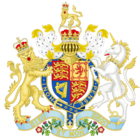
|
|
| Citation | 20 & 21 Vict. c. xcv |
| Dates | |
| Royal assent | 27 July 1857 |
| Text of statute as originally enacted | |
See also
- Cornwall Heritage Trust
Images for kids



